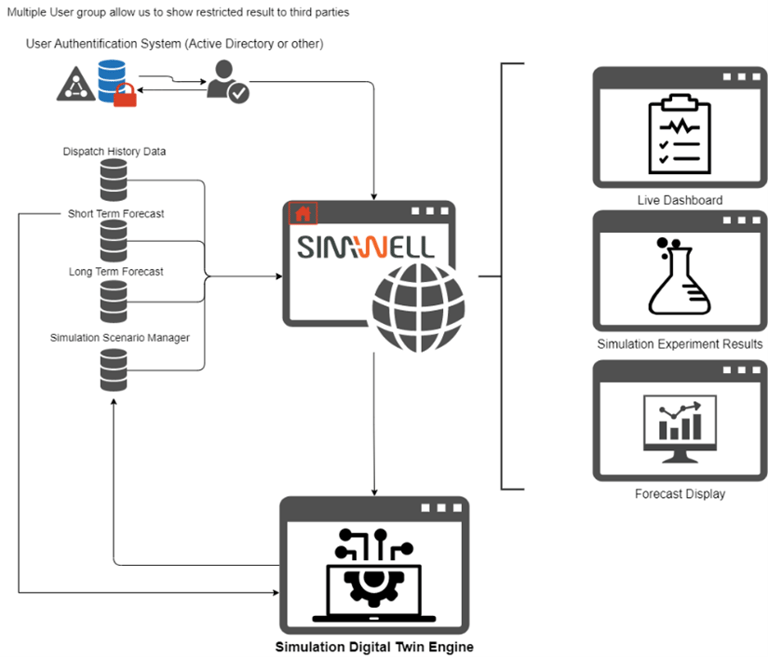Why forecasting trends isn’t enough and what leading teams are doing differently.
Simulation? That sounds like what we do in Power BI.”
That comment came from a visitor at a recent trade show, and it’s a common misconception. When a dashboard projects next month’s volumes or and your spreadsheet provides the plan, it may feel like you’re seeing the future.
But seeing a trend is not the same as understanding how your system behaves under stress.
Dashboards, spreadsheets, optimization, and simulation all support decision-making, but they do it in very different ways. And when the stakes are high, only one helps you rehearse the future.

Dashboards show what’s happening.
Most organizations rely on dashboards to monitor performance. They’re great for tracking KPIs, spotting trends, and flagging issues. But they can’t model how systems behave when conditions change.
Dashboards are descriptive. They tell you what happened, not why it happened or what to do next. They also tend to treat metrics in isolation. You might see that throughput is up at one station, but a dashboard won’t show you if that change is about to overwhelm downstream resources.
They’re essential for visibility. But they’re static.
Optimization shows what should happen.
Spreadsheets and optimization engines both try to find the best answer—based on the inputs you give them. Costs, constraints, and targets go in. The most efficient solution comes out.
When your environment is stable and the logic is clear, they’re powerful tools. But operations rarely stay stable.
Both spreadsheets and optimizers assume the inputs are accurate, the rules won’t change, and the structure will hold. They don’t account for what happens if a truck breaks down, if labor becomes constrained, or if demand surges unexpectedly. And they tend to give you just one right answer—for one exact scenario.
They’re efficient. But they don’t adapt.
Simulation shows how systems behave when conditions change.
That’s the real difference.
Simulation models the logic, timing, and interdependencies inside your operation. It accounts for queues, resource constraints, randomness, and process rules. And it does so dynamically, over time.
Instead of projecting a line forward, simulation lets you understand the range of likely outcomes so you know how decisions are likely to perform in the real world, before they go live. You can simulate what happens if demand doubles, if a supplier goes offline, or if you reroute traffic across your network. You’re not assuming stability—you’re stress-testing the system.
Think about a busy hospital emergency room. A dashboard might show current wait times. Your spreadsheet might suggest how many staff to schedule. But only simulation can test what happens when a flu outbreak hits, a trauma patient arrives, or half the nurses are diverted to a new wing. It models how queues form, how triage protocols kick in, and how patients move through the system minute by minute. That level of insight isn’t theoretical—it’s operational.
Simulation doesn’t give you a single answer. It gives you a space to explore what-if scenarios, evaluate tradeoffs, and make smarter, faster decisions with context.
Case in Point: From Waste to Wins in the Circular Economy
RPM eco, a recycling logistics provider, used simulation to reimagine its collection routes. The model factored in province-specific regulations, fluctuating volumes, and real-world traffic conditions. The result: a 30 percent increase in average pickup weight and a 90 percent reduction in empty pickups in some areas.
Dashboards couldn’t have predicted that and your spreadsheet models wouldn’t have uncovered it. Simulation made it visible before the trucks rolled.
Rehearse, Then Act.
Simulation isn’t necessarily a replacement for dashboards or spreadsheets. It’s the bridge between insight and action. When dashboards surface a problem and you work your spreadsheet model, simulation is how you test the plan under pressure.
You don’t need to simulate everything. But for complex, high-stakes, or system-wide decisions, simulation gives you leverage others don’t have.
Every system today is under pressure—from labor shortages to volatile demand and rising customer expectations. You can’t afford to experiment in the real world. Simulation gives you a safe way to fail fast, learn quickly, and scale what works. It shifts the question from “What happened?” to “What should we do next—and what happens if we’re wrong?”
Simulation won’t eliminate uncertainty. But it gives you the tools to create policies that help your system perform when a day is anything but average it. When your operation behaves like a living system, your decisions need to do the same.
It turns complexity into context and lets you act on it with confidence.
The organizations that rehearse, adapt. The ones that adapt, lead.
DOWNLOAD THE LATEST RESOURCE WE PREPARED FOR YOU
Discover how simulation helps answer critical What-If questions, optimize decisions, and navigate uncertainty with confidence. Explore eight key question types that drive smarter, data-backed business strategies.






